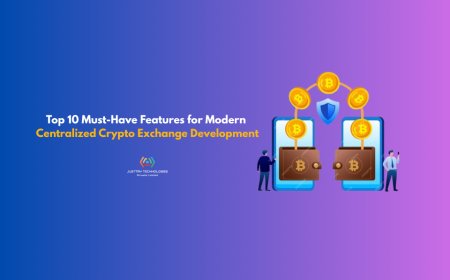How to Build Scalable dApps: A Deep Dive into Blockchain Development
Learn how to build scalable dApps with expert strategies, tools, and blockchain development services for high-performance Web3 apps.

As blockchain technology matures, the demand for decentralized applications (dApps) is surging across industries. However, building scalable dApps remains a complex challenge due to network limitations, storage constraints, and evolving user expectations. In this comprehensive guide, we'll walk you through how to build scalable dApps and highlight the crucial role a professional blockchain development company plays in delivering robust blockchain development services that are future-proof and performance-driven.
What Are dApps?
Decentralized Applications, or dApps, are software applications that run on a blockchain rather than a centralized server. Unlike traditional apps, dApps offer increased security, transparency, and user autonomy by utilizing smart contracts and distributed networks.
Key Characteristics of dApps:
- Open-source code
- Decentralized data storage
- Smart contract functionality
- Incentive mechanisms (tokens or rewards)
- Consensus-driven updates and operations
dApps are widely used in industries such as finance (DeFi), gaming, supply chain, healthcare, real estate, and social media.
Why Scalability Matters in dApp Development
Scalability is the capacity of a system to handle increased demand without compromising performance. For dApps, scalability is critical because:
- User base can grow rapidly
- On-chain transactions can increase congestion
- High latency affects user experience
- Gas fees may become unaffordable
If a dApp cannot scale efficiently, it will struggle with mass adoption and fail to deliver on its promise of decentralization.
Challenges in Building Scalable dApps
1. Network Congestion
Blockchains like Ethereum face transaction throughput issues, leading to delays and increased gas fees.
2. Data Storage
Blockchain isnt ideal for storing large files. Managing storage efficiently while maintaining decentralization is challenging.
3. Smart Contract Limitations
Writing complex smart contracts increases computation costs and can lead to vulnerabilities if not done properly.
4. User Experience
Maintaining a seamless, fast UI for users while ensuring secure blockchain interaction is a delicate balance.
5. Security & Audits
A scalable app needs a secure foundation. Any bug in the smart contract can result in significant losses.
Step-by-Step Guide to Building Scalable dApps
Step 1: Define Your dApp Use Case
Start with a clear idea of what problem your dApp solves. Is it a DeFi app? NFT marketplace? Supply chain solution?
Step 2: Choose the Right Blockchain Platform
Select a blockchain that supports scalability and aligns with your apps goals:
- Ethereum: Mature, but limited in scalability.
- Polygon: Offers Layer-2 scaling for Ethereum.
- Solana: High throughput and low transaction costs.
- Avalanche: Fast, flexible, and eco-friendly.
- Polkadot: Supports parachains for custom scalability.
A skilled blockchain development company can help assess which platform suits your needs based on transaction volume, speed, and budget.
Step 3: Design the Architecture
A scalable dApp needs:
- Off-chain data storage (IPFS, Filecoin)
- Smart contract logic
- Front-end interface
- Node/network integration
Use microservices architecture to break down functionalities, enabling easier updates and faster load times.
Step 4: Develop Smart Contracts
Smart contracts are the core of any dApp. They handle logic, rules, and automation.
- Use languages like Solidity (Ethereum) or Rust (Solana).
- Minimize complexity to reduce gas costs.
- Follow secure coding practices.
Many businesses rely on expert blockchain development services for secure and optimized smart contract development.
Step 5: Integrate Front-end and Back-end
- Use web3.js or ethers.js to connect your dApp to the blockchain.
- Ensure responsive design and real-time data updates.
- Maintain security on both front and back ends.
Step 6: Optimize for Scalability
- Use Layer-2 solutions (Optimism, Arbitrum)
- Implement sharding, sidechains, or rollups
- Use caching and off-chain computation
- Adopt decentralized cloud services (such as Akash Network)
Step 7: Test and Audit Rigorously
Testing is critical:
- Unit and integration tests for smart contracts
- UI/UX testing
- Load testing for performance under stress
Smart contract audits by professionals are essential to avoid vulnerabilities.
Step 8: Deployment and Maintenance
- Use CI/CD pipelines for seamless deployment
- Set up monitoring tools (e.g., Tenderly, Etherscan APIs)
- Plan for regular updates and governance (DAO structures)
The Role of a Blockchain Development Company
Partnering with an experienced blockchain development company can make or break your dApp. From concept to deployment, they offer end-to-end blockchain development services tailored to your project goals.
Key Services Offered:
- dApp consultation and feasibility analysis
- Blockchain platform selection
- Smart contract development and audits
- UI/UX design and integration
- Layer-2 and cross-chain solutions
- Ongoing support and upgrades
These companies help startups and enterprises alike mitigate risks, enhance security, and deploy scalable solutions across multiple blockchain networks.
Real-World Examples of Scalable dApps
1. Uniswap
A leading decentralized exchange that scaled using Ethereum Layer-2 solutions to reduce congestion and fees.
2. Audius
A decentralized music platform that leverages IPFS and Solana for fast content delivery.
3. Axie Infinity
A play-to-earn gaming platform that migrated to a custom sidechain (Ronin) for scaling.
These examples show how scalability can be achieved through the right tech stack and development strategies.
Tools & Frameworks for Scalable dApp Development
- Truffle / Hardhat: Development and testing
- Ganache: Local blockchain environment
- IPFS: Decentralized storage
- Infura: Blockchain access as a service
- Moralis: Backend support for dApps
- Chainlink: Oracles for external data feeds
Future Trends in dApp Scalability
- Modular blockchains like Celestia for better throughput
- Zero-knowledge rollups (zk-Rollups) for privacy and scalability
- Interoperability between chains (Polkadot, Cosmos)
- AI integration for intelligent automation
As the Web3 ecosystem expands, scalable dApps will become the foundation for everything from finance to the metaverse.
Conclusion
Building scalable dApps is not just about writing codeit's about strategic planning, selecting the right technology, and continuously optimizing performance. With the right approach and tools, developers can overcome the challenges of blockchain's limitations and create applications that are not only decentralized but also fast, secure, and user-friendly.
Whether you're an entrepreneur launching a startup or an enterprise exploring decentralized solutions, working with a reputable blockchain development company ensures your project benefits from professional blockchain development services that meet the demands of modern users. From smart contract development to post-launch support, their expertise is the key to delivering a dApp that performs well today and scales effortlessly tomorrow.

























